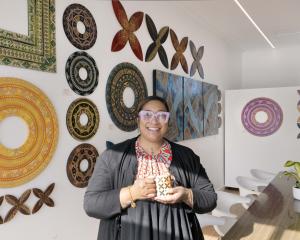
‘‘Three Naive Painters’’ (Brett McDowell Gallery)
Brett McDowell Gallery has grouped together three naive artists in its latest exhibition. As a style, naive art resembles traditional folk art and also primitivism, eschewing the techniques taught in art schools and instead bringing an almost childlike simplicity to the image. For these reasons, naive art is sometimes seen as being outside the gallery mainstream.
Dunedin's most well-known proponent of naive art is Ivan Hill, who recently celebrated his 83rd birthday with a show of new paintings. The three older works now on display at Brett McDowell's complement them well - they clearly show earlier steps along Hill's path. The most notable of the pieces is a massive triptych of Careys Bay which is both complex and exuberant.
Between Hill's works sit two of Dick Lyne's forestry series, works that depict the history of timber logging and simultaneously make subtle comment on the ecological harm caused by it. The paintings, with their perspectiveless flattening and bold wood diagonals, are surprising and strong.
The third artist, New Zealand-based Samoan Teuane Tibbo, is perhaps the best known of the three artists nationally, but little known locally. The artist's dark yet impressive Pacific Island scene combines naive style with folk narrative in an intriguing, narrative-laden image.

‘‘Dispora’’, Angus Collis (The Artist’s Room)
A former Otago Polytech art student, now based in Spain, is holding his first solo Dunedin show at The Artist's Room. Angus Collis spans style and place in his paintings, producing haunting work redolent of European cities and woodlands and small-town New Zealand.
The exhibition's title, "Dispora'', seems a portmanteau of diaspora (the outward drift of life from one place to others) and dysphoria (a general feeling of unease). This applies particularly well to these paintings, all of which seem unsettling, unreal impressions of place. Small towns, painted in a semi-naive style, seem too bright and clean to be anything other than memory trace. The empty cityscapes with their strident perspectives seem as alien as those of Hopper and De Chirico. The woods, also studies in perspective, seem too regimented, too neat.
Yet it is this unnatural nature that makes the works so compelling. The watery pink-browns of the railyard scenes hold the eye, as do the lines of forest trees, standing like tracks of rain running down a window.
The faded ochre and brown dream of Country Road, created in the unlikely medium of bitumen, is also memorable, bringing to mind inventor Niepce's first grainy nineteenth-century experiments in photography.

‘‘Rose Me Tender’’, Marion Beaupere (Gallery Fe29)
St Clair's Gallery Fe29 is displaying the first New Zealand exhibition of young French artist Marion Beaupere.
Beaupere describes herself as a "freelance traveller'', and her works spring from a combination of the photographs she has taken and the experiences she has had on her journeys in Southeast Asia and the Subcontinent.
Her geometric drawings often betray their origins through the inclusion of images taken directly from photographic landscapes, yet these are only the seed for the intricate kaleidoscopes that surround them. Forms cluster as if in a dream. Figures, skulls and, above all, startling geometries appear, wheels painstakingly crafted in ink that owe as much to fractal art as they do to star maps and ancient middle-eastern tile design.
Most of the images are created in a tinted monochrome, though some have the addition of bright rose ink, as is the case in the exhibition's title work. The largest of these pieces, which use art by Michelangelo and Dali as an inspiration, are astonishing in their complexity.
Alongside are several painted pieces that combine the ink patterns with colourful distended watercolour forms. Here, the suggestion of a Dali influence is clear, and the addition of the bright paint adds an intriguing three-dimensional appearance to the work.












